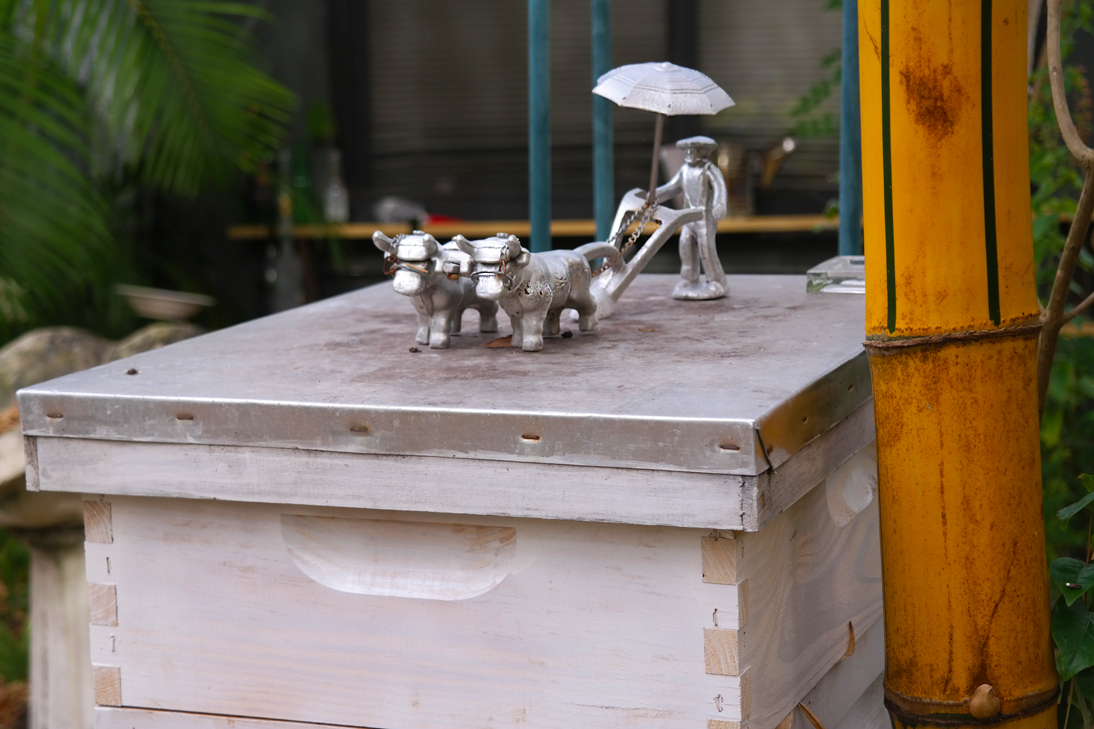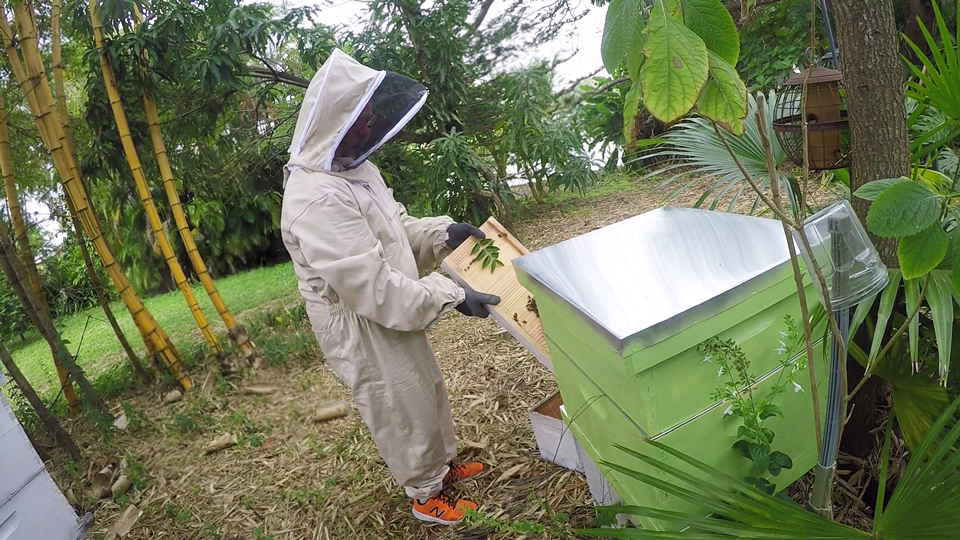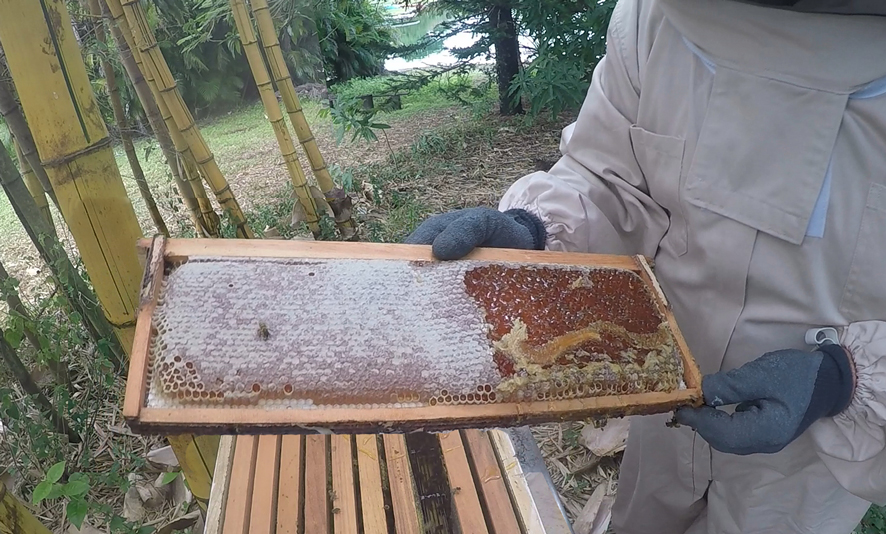
Hi, my name is Manny and I’m a beekeeper; beek for short. I started off as a normal gardener. You know, cucumbers, basil, radishes. But soon, as is what happens, you want more. You want to grow unusual plants; they whisper, “plant me.” Personally, I blame heirloom tomatoes. It’s a slippery path from there. Some stay with arugula as the unusual. I turned to aquatics — pond gardening — with tropical water lilies, floaters, duck potato and finally to bog plants, carnivorous ones. Soon, the pond had frogs, small herons, and minnows. But it wasn’t enough.
There was something missing: the complaints of neighbors. The silence can be maddening, so I convinced myself that the backyard had to go native: no more grass (as in Bermuda and St. Augustine). I slowly let the backyard rewild a little, a questionable strategy in Florida. I planted more natives. It became far less manicured, and soon it became a little oasis for birds, squirrels, and possums. I’ve even had owls and foxes. Cute. I put up bat houses. The neighbors started to wonder. They murmured and broke some of the silence.
But still, wilder and all, something was missing. Something that ties everything together: the land, the plants, the animals, the Paganism, and the neighborly shock. It was honey bees. When they joined the back yard, I clinched the neighborhood badge for crazy-weird. As one neighbor put it, “you are crazy as all fuck.” Then, I put on the ritual wear for the win.
Really, that was all just a bonus round. What actually got me to start beekeeping, was the decline of honey bees. About 10 years ago, we started to hear reports of “raptured” bees: colonies that just collapsed with no trace of bees, alive or dead. It was as if they just disappeared. Then came the alarming comment that made the rounds about humans having four years to live should honey bees vanish. To add weight, that comment would be reported as coming from Albert Einstein who, in fact, never said it. Researchers were quick to underscore the gravity of the situation but not the imminent extinction of the honey bee, though there were issues threatening them. The culprits ranged from a certain kind of mite that infects hives (varroa mites) to pesticides, specifically neonicotinoids (the link there offers a comprehensive review of research). While honey bees aren’t exactly doomed (U.S. colonies are at about three million) and there’s no danger of honey bee extinction, there’s still quite a bit humans can do to avert a beemageddon.

The tools of Orisha Oko [photo credit: M. Tejeda-Moreno].
That’s where Paganism comes in. Our responsibility to live with the land reminds us to ask what we can do to strengthen our bonds with the natural world around us. Bees can offer some of those insights, but not through a romance of bees, beekeeping, or an idealized view of the hive structure. I’m no fan of romantic portrayals of their societies as perfection. They’re not. They are a genetically-driven caste society of role-restricted female workers whose exhaustion is rewarded with execution. Queens do not control their hive; they exist for a singular purpose to lay eggs. Queens will be respected so long as they fulfill this duty. The moment their reproductive powers are compromised or a new queen is available, they are assassinated by their attendants through a process called “balling” whereby they are overheated and asphyxiated. Our personification of their world and their structure is a disservice to the honey bee. Unless your ideal society involves a totalitarian industrial complex, hives are nice to look at but I wouldn’t want to live there.
That’s not to say that we can’t learn from bees. In terms of society, there is something the bees do expose about ourselves: we have a deep-seated social fear to overthrow — or even criticize — our patriarchal system. Our history shows us that men have been undermining and usurping women-only spaces for the past ten to fifteen millennia, and the hive space is no different.
While many ancients believed bees to be a symbol of feminine strength and mystery, men tried to take that space as well. Aristotle, for example, and regardless of his debated intentions, comments in Historia Animalum (V 21) that those large bees that are referred to as “mothers” by some are, in fact, “kings.” Because of their order, bees were often thought of as male, creating a powerful and efficient social structure. Such commentaries highlight the pervasive attempt to classify the productive, the worthy, and the beneficial as the masculine. As a side note, the non-beneficial and economically uninteresting wasp has a “queen,” according to Aristotle. It further lays a persistent foundation of misogyny in the sciences that continues to today.
The Romans also referred to the queen bee as “imperator” or “rex.” Even Shakespeare mentions it in Henry V, act I scene II,
Creatures that by a rule in nature teach
The act of order to a peopled kingdom.
They have a king and officers of sorts;
Where some, like magistrates, correct at home,
Others, like merchants, venture trade abroad,
Others, like soldiers, armed in their stings,
Make boot upon the summer’s velvet buds,
Which pillage they with merry march bring home
To the tent-royal of their emperor;
Who, busied in his majesty, surveys
The singing masons building roofs of gold,
The civil citizens kneading up the honey
When it wasn’t industry, it was chastity. St. Ambrose, in Concerning Virginity, found the production of honey as a marvelous outcome of virgin labor and free of bitterness. He saw in bees a lesson for women: that servility, productivity, and chastity are pathways to purity.
Finally, in 1623, Charles Butler, the father of English beekeeping, wrote the first beekeeping guide, The Feminine Monarchie, where he asserted that hives were Amazonian. (He also published a theological defense for the marriage of first cousins, well that’s another story, never mind, anyway. . . )

Manny in ritual garb [photo credit: S. Ciotti].
The queen bee would transform again. As Father Jacques Vanière, a Jesuit priest, would write in The Bees (Canto II) in Praedium Rusticum (XIV):
She boasts her MALE SERAGLIO; unconfined
Her favours grans, and multiples her kind, so
When in apt season her intrigues begin,
No law has made polygamy a sin.
The Bees Her paramours, an idle, recreant race,
Dissolv’d in pleasure, and love’s soft embrace,
In sloth inglorious loiter in hive,
And from their vice the name of DRONES derive.
Well, that’s certainly a different, even unexpected and somewhat towards the opposite end of the previous commentaries, still in the context of Amazonian life only now with a freer view of sexual activity as well as male lethargy. Even today, we continue to have misogynistic bee terminology contaminating our language. We demonize the “queen bee” by using the term as a gendered assault on powerful women.
Despite Butler’s grounded assertions, the patriarchal usurping of the bees as masculine continued well into the 18th century. Finally, someone pointed a microscope at the right part. That someone seems to have been Swiss entomologist Marie-Aimée Lullin, who through observations and dissection unequivocally demonstrated the sex of honey bee workers and queens as females. Science triumphs.
Ultimately these stories are about what the powerful humans — mostly men — want the bees to mean. I have to admit that I’m not much of a fan of bee lore and what socio-spiritual secrets insights bees stories can teach us. The patriarchy is one crafty engine, but the bees are craftier.
Their magic is not about meaning, it’s about presence: a presence filling the immanent world around us. They are messengers of that magic. In Lukumi, for example, Orisha Oko is the Orisha of fertility and agriculture. He calls order from the chaos of nature and it is through him that fields and gardens come alive. Oko is the vibrancy of life, and his messenger is the honey bee. The message is the observable connection to nature.
I would argue that our anthropomorphic obsession to romanticize the hive blinds us to a real opportunity to learn from nature: bees join in our stewardship of the land. Caring for them, offers us an opportunity to experience the intimacy of a balanced world. When bees came to my back yard, they joined with it. They transformed the land around them. They returned a vibrancy to the garden. They are pollinators for the plants and a food source for many birds. That was the unexpected consequence for me when I took up beekeeping. They added balance.
The intimacy also appears in the honey. As a product, it is more than the labor of the bees, it is the taste of the land around you. It is the sum of every drop of nectar in a four-mile circular area around the hive. The honey reflects the land. It has terroir, for sure, but more importantly, it is the flavor of all the life around you. The nectar offered by flowers is the transformation of light into sugar made from components found in the air and in the soil. What is in the soil and in the air, is in the nectar, and what is in the nectar is in the honey. That transformation is also powerful: nature is changing everything into life. Through honey bees, you get to taste that conversion.
The world tries to distract us from that deep analysis of what the honey bee can represent. Every side of the political spectrum seems to want to adopt the honey bee as an icon. The right portrays honey bees as examples of industry, the left as images of environmental frailty. They are bourgeois and proletariat. They represent small government and superstructure.
It’s here that honey bees intersect with human political activity. We have the power through our decisions and behaviors (now unlike ever before) to promote conditions that can shape how bees can thrive or how bees can be devastated. Honey bees teach us that. Not through their decline, but rather through their success.

Honey harvest [photo credit: S. Ciotti].
When we think of honey bees, we really think of the European honey bee, apis mellifera. They aren’t native to much of the West. There were no honey bees in California before 1853; they were brought to San Jose during the gold rush years. Honey bees didn’t exist in the Americas before they were brought to Jamestown in 1622. Honey bees were introduced into Australia aboard the ship Isabella in 1822, and they have displaced the native Asian bee since their introduction in China in the late nineteenth century. Honey bees as managed colonies support the land. Honey bees as feral colonies are an invasive species, and humans have been the facilitators of their introduction. They are managed colonies of human intervention. Their global presence is because of human activity. We are the culprits behind their introduction, their damage, their benefit, and their growth. Bees are teaching us our relationship to the Earth.
We don’t have a good grasp of how much they may have displaced native pollinators. Nor do we understand how much they promote the spread of invasive plants by offering their pollination services. They may even alter the availability or scope of food sources available to birds and other animals by altering the productivity of native food sources. We just don’t know the answer to the many questions about their impact, but we do know what benefits they can offer and how the choices we make help them heal the land around us. We can witness their transformative power on the land, just like we can with humans: the good, the bad, and the balance.
Happy Earth Day
* * *
The views and opinions expressed by our diverse panel of columnists and guest writers represent the many diverging perspectives held within the global Pagan, Heathen and polytheist communities, but do not necessarily reflect the views of The Wild Hunt Inc. or its management.
The Wild Hunt is not responsible for links to external content.
To join a conversation on this post:
Visit our The Wild Hunt subreddit! Point your favorite browser to https://www.reddit.com/r/The_Wild_Hunt_News/, then click “JOIN”. Make sure to click the bell, too, to be notified of new articles posted to our subreddit.